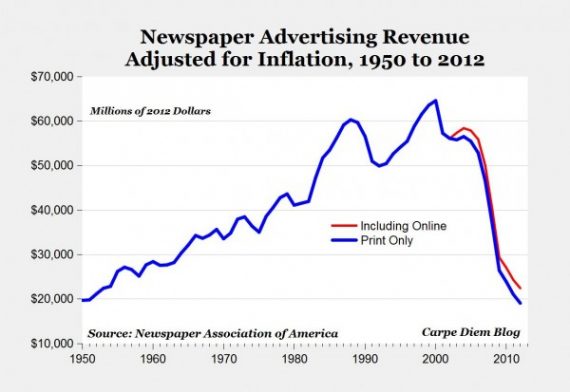Chart Of The Day: Death Of Newspapers Edition
Mark Perry uses this chart to illustrate something quite astounding about the newspaper business:
Perry comments:
The blue line in the chart above displays total annual print newspaper advertising revenue(for the categories national, retail and classified) based on actual annual data from 1950 to 2011, and estimated annual revenue for 2012 using quarterly data through the second quarter of this year, from the Newspaper Association of America (NAA). The advertising revenues have been adjusted for inflation, and appear in the chart as millions of constant 2012 dollars. Estimated print advertising revenues of $19.0 billion in 2012 will be the lowest annual amount spent on print newspaper advertising since the NAA started tracking ad revenue in 1950.
The decline in print newspaper advertising to a 62-year low is amazing by itself, but the sharp decline in recent years is pretty stunning. This year’s ad revenues of $19 billion will be less than half of the $46 billion spent just five years ago in 2007, and a little more than one-third of the $56.5 billion spent in 2004.
Here’s another perspective: It took 50 years to go from about $20 billion in annual newspaper print ad revenue in 1950 (adjusted for inflation) to $63.5 billion in 2000, and then only 12 years to go from $63.5 billion back to less than $20 billion in 2012.
The red line shows what’s happening when you include online ad revenue. As you can see, it’s done absolutely nothing to stop the slide, and the more newspapers are forced to move online, the more they are going to have to find a revenue model that doesn’t depend so much on advertising.
H/T: Andrew Sullivan







Yup, that is a heck of a story in one chart.
Like hiking prices for subscribers? The cost of subscribing to my local newspaper has gone up almost 300% since 2005. I’m letting my subscription lapse rather than take another rate hike. I can read the newspaper online for free and buy at the newsstand the Wednesday and Sunday editions which my wife likes for the coupons and sales circulars.
Yikes, 300% hikes? My annual subscription is up for renewal and it looks like its up just over 10% over last year, but the content has diminished by about 20% as well. This is the first time I’ve ever thought about not renewing.
@PD Shaw:
A 13 week subscription has gone from $26 to $74.
The question that I haven’t seen asked is why? Internet usage? I don’t think that’s enough to explain the decline. Internet usage in the U. S. hasn’t changed that much since 2000 and it certainly hasn’t changed that much since 2004.
The availability of broadband in the home?
I’m open to suggestions.
@Dave Schuler: Craiglist.
@Dave Schuler:
I did some work for auto dealers a little while back. Those guys were always good for pages and pages in the weekend papers … all were shifting ad dollars on-line.
@Andre Kenji:
The history of Craigslist’s expansion doesn’t really support the timeline.
Diminished reading habits, online, cable TV, less news intake, word of mouth, tablets, our life schedules and various other items vying for our attention and entertainment. Also there’s the reduced volume and quality — or at the very least the equally dangerous perception thereof. Probably some other things we haven’t yet really put our finger on.
Reading a newspaper is often an inherited trait, too. My undergrads, who’s parents would be Gen Xers, don’t read papers. There’s nothing surprising there, myopic cliches about students abound. Their parents often don’t read the paper either.
I keep wondering if print books will go the same way; I see more of the e readers and many books are available on line through the public library for free. It won’t be long before there is a generation that does not know what a newspaper is. The schools had newspapers in the classroom long ago, now it’s news from Channel One on the internet. Our local paper kept cutting and cutting. That is one reason we stopped subscribing. The newspapers used to call frequently to try and get us to buy, but that stopped years ago.
seems right to me, my paper tried to hike my rates 5 yrs ago and i just dropped them- i can read news online anytime and not feel bad about dead trees. and the heck with ‘letters to the editor” we can all just yell and scream at each other in real time!
@Carson:
Reading newspapers is an inherited trait, but it’s also one that can be broken. I used to read two newspapers a day when I was in college and law school (no, I didn’t sleep).
I canceled the delivery subscription to The Washington Post almost seven years ago and switched to online mode, and I haven’t missed a thing.
Let’s face it, at some point people are going to think that it was pretty silly that we used to get these thick piece of paper delivered to us every day (and one the size of a concrete brick on Sundays).